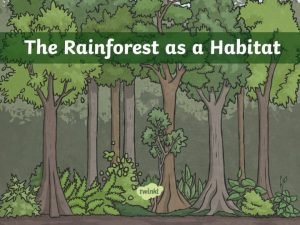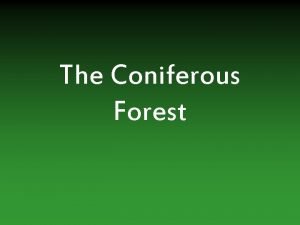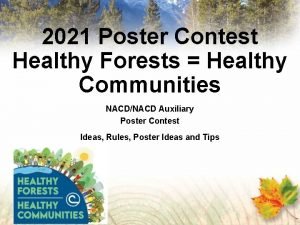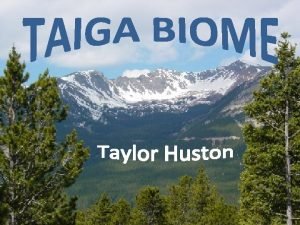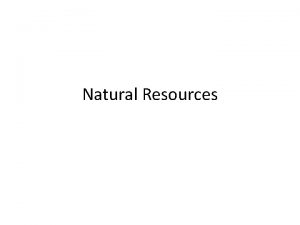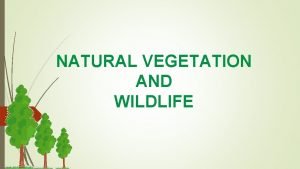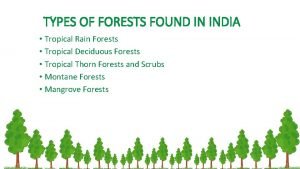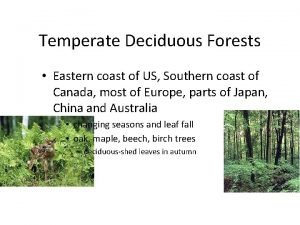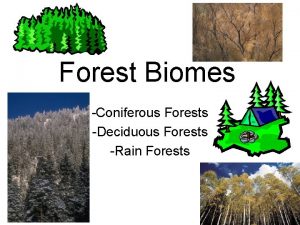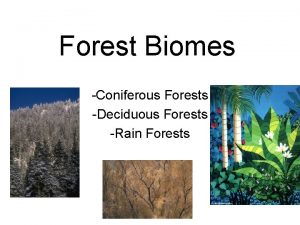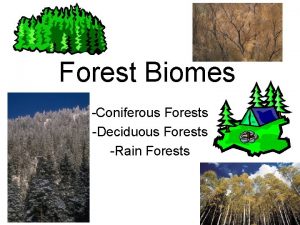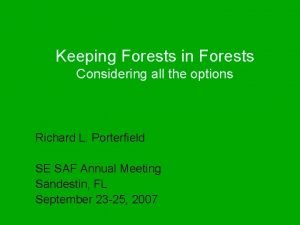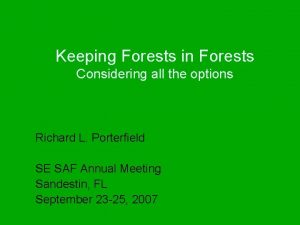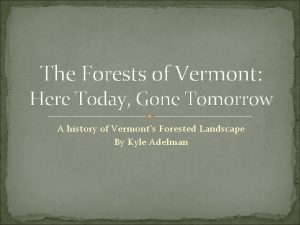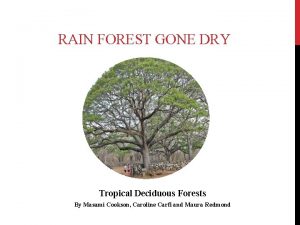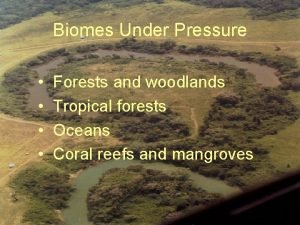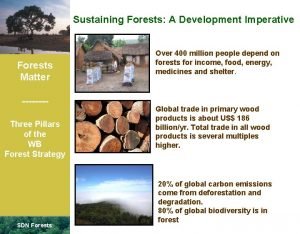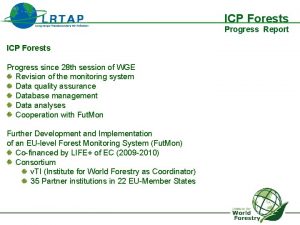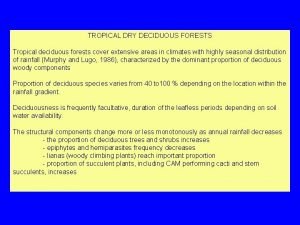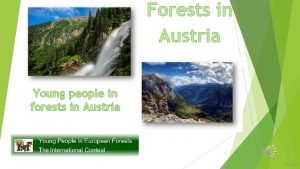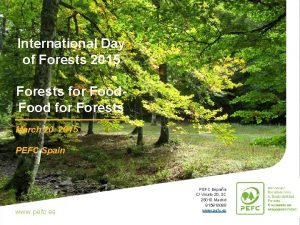Where have all the forests gone A History































- Slides: 31

Where have all the forests gone? A History of Deforestation in Vermont By Charles Dabritz

Have you ever seen a stone wall in the middle of the woods? That means the land you are looking at was once cleared. Look at this picture from St. Albans taken in 1890. The fields are open and lined with stone walls. (LS 07406)

The forested landscape we know today is a new development. Here, a typical fall scene with a farm and wooded hillside in the distance. Washington, 1959. (LS 01993)

One hundred years ago, the state was a different place, with over 70% of the land cleared. (1) Here you can see the cleared hillside of Table Mountain in Stockbridge. June, 1897 (LS 07428)

The struggle to find a balance between humans and the forested landscape of Vermont has been a long one. This is the statehouse in Montpelier around 1900. Notice the hill behind the state house has been completely cleared. (LS 04027)

The first European settlers began the deforestation of Vermont. They lived as farmers, clearing land to meet their needs. Very much like this farm in Tweed Valley, 1897. Both the hill and valley have been cleared. (LS 07409)

Danville (no date)LS 03876 The first farmers had a tough job to do. They had to farm in an area that was not always fertile, very rocky, and certainly not flat!

By 1840, most Vermonters lived or worked on a farm, but this would soon change. This illustration from the 1800’s shows a group of Merino sheep started a ranching craze in Vermont in the mid 1800’s. No date. (LS 00409)

By the 1840’s there were 6 sheep for every 1 person Sheep grazing in St. Albans. No date. (LS 00666) (2)

Ranching became a popular way to use the land, because sheep can graze on almost anything. All over Vermont people cleared land to feed their sheep and their bank accounts. Here a Lyndon sheep rancher keeps watch over his flock. No date. (LS 04384)

Ranching died out in the 1850’s, but Vermonters discovered something else to keep their land their minds occupied…buried treasure. A miner in Johnson around 1937. (LS 02223)

The treasure was not gold or silver, but stone…slate, marble, granite, and many other rocks were taken out of the earth. A slate quarry and mill in Fair Haven, 1907. (LS 00684)

Trees were cut, and the ground dug into to extract the heavy stones… This granite quarry in Barre shows workers and a large derrick that was used to lift the stone. No date. (LS 02207)

The geology of Vermont yielded a wealth of usable rock… Here people work in a marble quarry in Proctor, 1920. Look how they cut into the earth to get out the rock. (LS 02247)

No gold, no silver, but there was at least one metal found…copper. The copper that was mined in Vermont left a lot of waste behind. Look at the effect of the waste on the landscape at the Ely copper mine in Fairlee. What happened to all the trees? 1896. (LS 01535)

The trees were needed to fuel the fires to smelt the ore. Poisonous gasses produced in the process killed many others. . The smelting furnace from this mine in Vershire, no date. (LS 04752)

Vermont’s forests continued to shrink once people found ways to move its trees to other places. Logging became the biggest industry in the state. The men in this picture are pulling logs from a river to send to the mill. This is the Smith Mill in Granby. 1890. (LS 02156)

A good price for lumber created a clear cutting phase in Vermont’s history. This painting from the 1850’s shows the an early phase of that process. Look how all the trees are beginning to be removed. (LS 00849)

Once trees were cut there were several ways to get them to a mill or port… Sometimes logs would be “driven” down stream in large numbers, and then stacked like in this photo. No date. (LS 02112)

The use of railroads allowed wood to be moved more quickly and with less cost. Once wood was stacked, it could be loaded onto trains and hauled in large numbers. This photo from East Haven shows men loading logs onto a train. No date. (LS 02158)

So many trees were shipped out of Vermont that Burlington, on Lake Champlain, became one of the biggest timber shipping ports in the United States! (3) Several children look down on the lumber port from Burlington’s Battery Park. Look at how the railroad tracks lead right into the port. No date. (LS 00078)

Logging had a huge impact on the landscape. By the 1870’s the forests were so depleted much of the wood shipped from Burlington came from Canada. (4) Here is another view from Battery Park. Notice all the stacked lumber ready to ship. No Date (LS 02972)

New technologies brought new challenges… The automobile stuck in the muddy dirt road would need some help. Rutland, 1914 (LS 06466) More land was cleared to pave roads and make way for the future… Barton, 1908. (LS 07028)

As the population increased, so did the need for better roads. Vermont was ready to join the Interstate Highway system. But first they had to turn this: The future site of the interstate in Sharon-Royalton. 1967 (LS 07120)

Into this: Not only did they need to clear a path for the road, but notice the area around the future highway. It has been cleared to support the construction. Montpelier, 1959 (LS 04414)

Even the rocky terrain of Vermont did not stand in the way of these new generation roads…both trees and rock were cleared to make way for I-89. A crane and boulders rest in what will be Interstate 89 outside of Montpelier. 1959 (LS 06102)

Not until the 20 th century did people began to “preserve” forests, and think about ways to interact with their environment in nondestructive ways. Here two men plant trees. Look at all the saplings the man in the background has in the basket. No date (LS 05766)

With ample time and care, forests have returned to Vermon Old view of Topsham No date. (LS 00352) These two views of Topsham show extensive reforestation of the area. Where land was once cleared, trees have taken over. Present view, 2000

Vermont still has farms and quarries. People still raise sheep and log their land, but new practices have been developed so these are done more in balance with the natural landscape. Here you can see a farm in Peacham with a forested background. 2004 (LS 00026) And sheep grazing at Shelburne Farms. 2004. (LS 02960)

Reforestation has taken hold in Vermont. By looking at our past, we can become more aware of our future, and ensure that the forested landscape of Vermont is used in a healthy, productive manner. The once cleared hillside behind the state house has now been reforested. 1900. (LS 04027) 2000. (LS 00226)

Resources: 1. Albers, Jan. Hands on the Land MIT Press. Cambridge, MA. 2000 p. 202 (back to slide 4) 2. Albers, 246 (back to slide 9) 3. Albers, 226 (back to slide 21) 4. Albers, 225 (back to slide 22) All photos are found as part of the Landscape Change Program at: http: // www. uvm. edu/landscape For information on the early settlers impact on the environment see: Cronon, William. Changes in the Land. Hill and Wang, New York. 1983 For information on New England’s sheep craze see: Wessels, Tom. Reading the Forested Landscape. Countryman Press. Woodstock, VT. 1997
 Where have all the young people gone
Where have all the young people gone Where have all the criminals gone
Where have all the criminals gone Presente simple en ingles
Presente simple en ingles Where have you gone charming billy
Where have you gone charming billy Must 의문문
Must 의문문 Where have you gone charming billy
Where have you gone charming billy What is prufrock's problem
What is prufrock's problem I have gone marking analysis
I have gone marking analysis Is characterization a literary element
Is characterization a literary element Name three lines
Name three lines Kumudvan vrindavan
Kumudvan vrindavan Primary producers in kelp forests
Primary producers in kelp forests Plants and animals in the temperate forest
Plants and animals in the temperate forest Very dense, warm and wet forests.
Very dense, warm and wet forests. Tropical thorn forests and scrubs
Tropical thorn forests and scrubs Coniferous definition
Coniferous definition Healthy community poster
Healthy community poster Coniferous definition
Coniferous definition Materials or substances such as minerals forests
Materials or substances such as minerals forests Temperate forest average precipitation
Temperate forest average precipitation What is natural vegetation
What is natural vegetation Tropical thorn forest and scrubs
Tropical thorn forest and scrubs Deciduous forests are found primarily in africa.
Deciduous forests are found primarily in africa. Apes frq 2014
Apes frq 2014 8 vertices and 6 faces.
8 vertices and 6 faces. Banter vs bullying examples
Banter vs bullying examples Christina rossetti remember
Christina rossetti remember Went vs gone
Went vs gone Plastic surgery gone wrong
Plastic surgery gone wrong Past participlewrite
Past participlewrite Gone too far childnet
Gone too far childnet Saigon is gone poem
Saigon is gone poem













